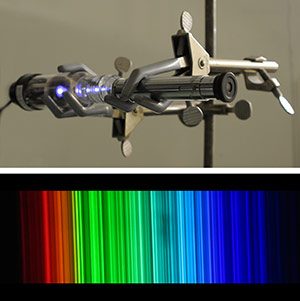March 26, 2014
Researchers at the National Institute of Standards and Technology (NIST) have rejuvenated a technique for finding planets near distant stars.* New measurements of light from special lamps could help astronomers find planets hidden in data from more than a decade's worth of extrasolar planet searches, as well as improve telescopes' current capabilities.
Finding extrasolar planets is tricky. Seen through a telescope, planets in the "habitable zone"—a region close to a star, where liquid water could exist on a planet's surface—usually get lost in their star's glare. But as a planet orbits, its gravity makes its parent star wobble a tiny bit, resulting in slight color changes in the star's light due to the Doppler effect. These changes can only be spotted if the light is first broken into a spectrum of thin lines, which are then compared to an unchanging reference spectrum.
"It's like holding one ruler in front of another and moving the front one to the right and left," says NIST physicist Gillian Nave. "You can see the front ruler move compared to the one behind it. The star's spectrum is the front ruler, which moves as the planet tugs at it. But the movement is so small that to see it clearly, we need to put a fixed ruler of very high quality behind it. That's where NIST comes in."
The NIST team made extensive new measurements of thorium, a heavy element often used in emission lamps that help provide that fixed ruler. Scientists have detected more than 400 planets using the Doppler technique but have yet to discover a solar system similar to ours. The new data could help, says Nave.
"Earth causes the Sun to move at a snail's pace," says Nave. "We don't yet have techniques that can find planets of that size, but our new data will get us much closer."
Stephen Redman, a postdoctoral fellow working at NIST, worked with Nave and physicist Craig Sansonetti to update the most recent thorough measurement of thorium's spectrum, published in 1983. The more than 8,000 spectral lines it lists are a bit fuzzy by today's standards—good enough to reveal the larger wobble caused by a Jupiter-sized gas giant's gravity, but not the small one an Earth-like world would cause. Redman spent a year combining observations he made on a spectrometer at NIST with data culled from other researchers' work. The result is a set of nearly 20,000 spectral lines of far greater clarity.
In addition to finding systems similar to our own, the new data should aid the search for planets around dwarf stars. These have been hard to find using the Doppler method, in part because dwarfs are so faint, but Nave says the new data include good lines in the near infrared, which is the region of the spectrum in which many of these cool stars give off the most light.
"We've already had astronomers from several telescopes ask if they could use the data for planet hunting," Nave says. "With luck, the measurements will help us search for planets near stars whose wobbling has been hard to detect."
*S.L. Redman, G. Nave and C.J. Sansonetti. The spectrum of thorium from 250 nm to 5500 nm:Ritz wavelengths and optimized energy levels. Astrophysical Journal, DOI: 10.1088/0067-0049/211/1/4, February. 2014.















